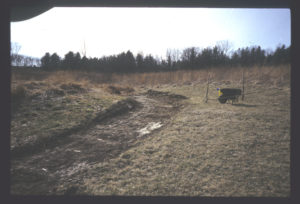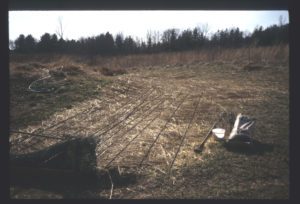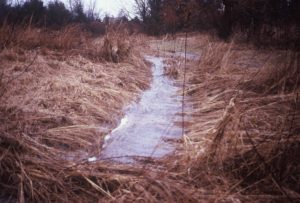Spillways Cope with Excess Water
While it is relatively simple and inexpensive to design and build a grassed spillway to cope with overflow from a small pond in a small watershed, it seems inevitable that you will also get a torrential rain and aggressive overflow right after it is built and before the grass gets a chance to grow a sod to protect it from erosion. So it is a good idea to assume that this will happen, and design for it, so that erosion protection is available from the moment you build it. My method, which has worked quite well, is illustrated with the sequence of photos that follow:
- Build it in early spring so the grass is ready to grow as soon as planted and April showers will keep it watered.
- Dig the spillway wide enough to spread the overflow out thinly, and make it gently graded with no abrupt drops, because these will become erosive little waterfalls in a heavy runoff. Dig it into firm original soil with no added backfill:

- Plant the spillway with little dormant sod chunks of prairie cordgrass, about 3” x 3” x3” square on about 18” centers. Set the chunk tops flush with the spillway soil.
- Seed the spillway surface with oats and unroll a plastic erosion control mesh:

- Bury the upper end of the mesh blanket into a trench, pounding the dirt tightly back in so water flow cannot lift the mesh. Pin the mesh with sod staples:

- Spread an inch of crumbly dirt over and into the plastic mesh. Seed it with annual rye and perennial rye. (The oats will be up in 7-10 days but die away by midsummer. By then the annual rye will dominate and die with a heavy frost, but the perennial rye will return the next spring when the cordgrass is starting to spread.)
- Thinly cover the seeded soil with straw or hay laid crosswise to flow. Anchor it temporarily with lengths of rebar laid longways, water if necessary:

- And here comes the first overflow while the oats are a few inches high and the annual rye is just coming up. Note that the six inch rocks spread at the base of the spillway to spread out the flow are inadequate:

- Remember to remove the rebar while you can still find it under the grass.
- Two springtimes later the native cordgrass will have developed a durable sod resistant to erosion, replacing the perennial rye.

- If your inch of dirt atop the plastic mesh is still there and damp, you can run a prairie burn through the cordgrass without harming the plastic.
- The first five photos illustrate construction of a spillway for a well-vegetated 14-acre watershed, the last one shows overflow from a well-vegetated 10-acre watershed. Ponds in larger watersheds need additional water management design, including a trickle tube, to be continued in future weeks.


